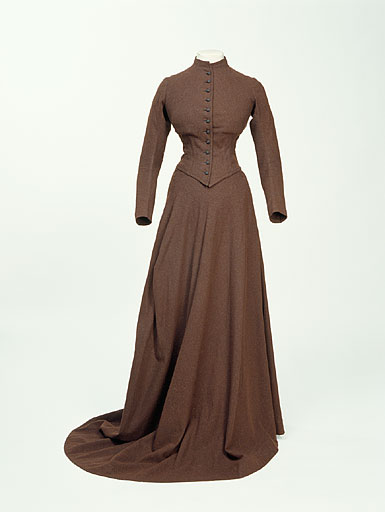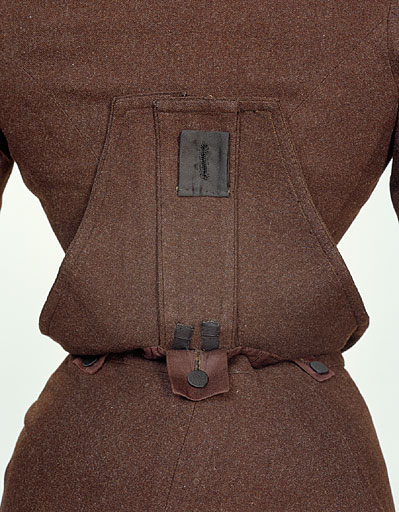riding habit
Summary
Brown, woollen twill cloth, and chamois leather. Jacket: Lightly boned, with narrow standing collar, fastening down centre front with 11 black braid buttons; front shaped with darts, waistline with central point; back in 5 shaped sections, 3 central sections shaped into tab at centre back; two buttons at waist; long sleeves with two buttons at cuff; inner waistband hooking at front; three vertical buttonholes each on tab from waist across back and one at end of back tab; woven tape loop at neck: "Nicoll's Manufacture London & Paris". skirt: cut in three pieces - two large and one smaller cross secion, with shaping for knee on right, wrapping over and fastening at left with four concealed black silk buttons and two hooks and eyes on waistband; three buttons across back to fasten to jacket; slit pocket on left under opening; sections of lining at top right; elastic loop at back hem; tapes inside waist; breeches: upper part to knee of chamois leather, lower legs of same cloth as jacket and skirt but with reverse of fabric turned outwards; waist lined with cream silk, open at top each side, fastening with four linen buttons, one pair of metal buttons each side of leg at ankle, stamped "Nicoll 114 to 120 Regent St" woven label at waist; "H.J. Nicoll 114 116 118 120 Regent St. 21 22 Cornhill".
Display Label
A masculine influence pervaded women's riding dress during the 18th and 19th centuries, partly because ladies' habits were not generally made by the dressmakers who traditionally made women's clothes, but by specialist tailors or habit makers. Women also selected headwear like tophats and bowlers, although they then softened or "feminised" them by attaching net scarves. Habits from the period often featured military-style frogging or braid as seen in fashion plates of women's riding dress, which usually appeared in tailors' journals, and only occasionally in ladies' magazines. (see the Heideloff plate below) This slant towards masculinity provided endless source material for magazines like Punch, which regularly published cartoons showing aggressive women riders. More realistically, early outdoor photographs from the 1850s onwards provide a clear indication of what actual women chose to wear on horseback. Grooms, also, are often depicted holding the reins of their master's fine horse in eighteenth century portraits as below. The chestnut-brown cloth riding habit in the main image has a short, fitted bodice and a matching voluminous skirt with side train to cover the knees when sitting side saddle. An innovative fastening under the jacket skirt prevents the jacket from moving upward, and the skirt, cut with extra room on one side, enables the wearer to ride side saddle in comfort.
Object Name
riding habit
Creators Name
Date Created
1880-1890
Dimensions
Length (breeches): 108cm
Length (skirt): 135cm
Length (jacket): 60cm
Waist (jacket): 60cm
Waist (skirt): 60cm
accession number
1951.423
Collection Group
Place of creation
London
Medium
Legal
© Manchester Art Gallery




